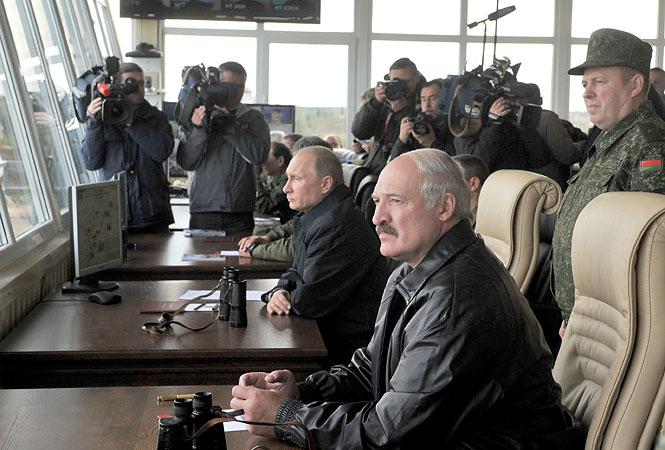 (Image Source: president.gov.by)
(Image Source: president.gov.by)
Could Belarus’ Cold Shoulder to Russia Signal a Thaw to the West?
Known as the last dictatorship in Europe, Belarus has long served as a vitally strategic buffer between Moscow and Europe. A long-term member of the Russian-led regional security pact, the Collective Security Treaty Organization (CSTO), a bilateral member of the supranational Union State of Belarus and Russia, and a perennial recipient of substantial Russian subsidies, Belarus has played its part as a steadfast Russian partner. Recently, however, through a series of disagreements over debts and perceptions of Western “rapprochement,” Belarusian President Alyaksandr Lukashenka has indicated that this alliance with his Russian neighbor may appear to be slightly less stable than previously assumed by many Western outsiders. Sanctions and on-going diplomatic efforts used by the EU and the US to isolate Belarus over the past decade have further propelled Minsk to rely upon Russian patronage. Should the EU and the US decide to exploit the potential rift in Russian relations with measured reforms and sanctions easing, it could set a course in achieving improvements in Belarusian integration with Western institutions.
Belarus has steadfastly maintained a neutral stance in the on-going Russian/Ukrainian conflict since 2014. Shortly before the official Russian annexation of Crimea, President Lukashenka spoke in support of Ukrainian territorial sovereignty and quickly recognized the new Ukrainian leadership under Petro Poroshenko following Ukraine’s Maidan Revolution, upsetting many in Moscow. Lukashenka’s government has even acted as host and intermediary for the Minsk agreements, the on-going ceasefire discussions between Russian and Ukraine. In 2015, the Russian government pushed to establish a military airbase on Belarusian territory, most likely intended to help resupply and stage aircraft closer to the NATO sphere of influence, and was outright rejected. Growing fears of a Russian “little green men” style invasion have seen Belarusian media creating an abnormal amount of outcry over the hosting of the bi-annual Russian/Belarusian military exercise Zapad 2017, forcing President Lukashenka to proclaim that Russia “is never going to occupy Belarus.”
Most recently, tensions and tit-for-tat diplomatic measures and scheming has engrossed relations between the two longtime allies. In the wake of slumping oil prices, Belarus has demanded a “fair price” from Russia over rising fuel delivery prices, to which the Russians responded by supplying approximately 40% less oil to Belarus. In addition, Russia has proceeded to press for immediate debt-repayment of $550-million from the financially strapped Belarus. In February of 2017, Belarus lifted its short-term visa requirement for visitors to Belarus, to include EU member-nations and the United States. In response, under the guise of protecting Russian security, Russia’s Federal Security Service established a restrictive secured border zone between the two nations, the first of such kind since 2000.
The chilling effect of these latest incidents between Belarus and Russia provides both the European Union and the United States with a substantial rapprochement opportunity, or at the very least, modest compromises in shifting Belarusian interests away from the long-standing Russian sphere of influence. Though it is unclear how the Trump Administration will tackle on-going relations with Belarus, the country does offer intriguing potential for foreign interest beyond the realm of geopolitical security. With special regards to the emerging technology sector, Belarus is quickly becoming known as the “Silicon Valley of Eastern Europe,” a tribute to a sizeable well-educated, lower-wage STEM workforce. Optimism of opening relations and opportunity, however, must not come without some realistic checks on expectations toward any sort of a “progressive Belarus.”
Human Rights Watch routinely lists Belarus near the bottom of national civil liberty rankings while President Lukashenka is well-known for his crackdowns on political opposition. In 2016, civil liberty concerns notwithstanding, the EU council officially lifted its 12-year Belarusian targeted sanctions, citing “improving EU-Belarus relations.” It is assumed more than likely that this move by the EU was more of a geopolitical thrust aimed at further separating the Russian-Belarusian alliance than a ringing endorsement of internal reforms in Belarus.
In Belarus, there remains much work to be done to markedly improve its ongoing Western-relationship. President Lukashenka, pitched with the decision of European-style reform or maintaining the subservient partnership with Russia, is quickly running out of time and money. Though a complete overhaul of Belarusian governance is unlikely, the United States and the EU should focus on the “low-hanging fruit” of potential economic and security cooperation. A combination of encouragement towards measured internal reform while providing a clear glidepath of easing restrictions and sanctions is a successful blueprint, and could signal the beginning of an emerging, vitally strategic Belarusian partnership.





